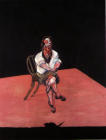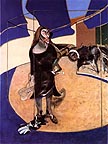|
THREE WOMEN
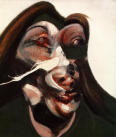 |  |  | Isabel Rawsthorne
by
Francis Bacon | Muriel Blecher
by
Francis Bacon | Henrietta Moraes
by
Francis Bacon |

photo by John Deakin
- MURIEL BELCHER: (Started the Colony Room in 1948):
MURIEL BELCHER, "A handsome, Jewish dyke," as one Colony Room club member recalls, started the club, also called 'Muriel's by the older clientele, in 1948 and ran it till her death in 1979. "Muriel was a benevolent witch, who managed to draw in all London's talent up those filthy stairs. She was like a great cook, working with the ingredients of people and drink. And she loved money." (Melly) She attracted many gay men to the club - a lot of them brought in by her Jamaican girlfriend, Carmel. Belcher had good antennae for interesting people, gave Bacon free drinks in return for new custom and established the Colony's close-knit member profile. 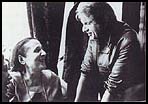 She also established a cult of rudeness. Belcher's favourite word was "cunt", delivered in ringing tones, and a hierarchy of insults ensued. "'Cunt' was a term of abuse, 'Cunty' was meant affectionately," says the Chairman. "And if she called you 'Mary', you were really in." Men would be called "she". "Muriel made everything sound good, even when it wasn't exactly a Wildeanepigram," says Melly. "She was camp, and the very delivery of camp makes your sentences sound witty." The Colony thus became a kind of anti-Cheers, where everyone may have known your name but instead called you "cunty." She also established a cult of rudeness. Belcher's favourite word was "cunt", delivered in ringing tones, and a hierarchy of insults ensued. "'Cunt' was a term of abuse, 'Cunty' was meant affectionately," says the Chairman. "And if she called you 'Mary', you were really in." Men would be called "she". "Muriel made everything sound good, even when it wasn't exactly a Wildeanepigram," says Melly. "She was camp, and the very delivery of camp makes your sentences sound witty." The Colony thus became a kind of anti-Cheers, where everyone may have known your name but instead called you "cunty."
Licor-ish: by Oliver Bennett
Guardian Unlimited, Saturday January 16, 1999
above: Muriel Belcher & daughter (Belcher's name for Francis Bacon) at Wheeler's Resturant, photograph by Peter Stark
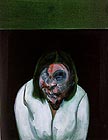
FRANCIS BACON
Head of a Woman (Muriel Belcher), 1960
oil on canvas (artnet.com)
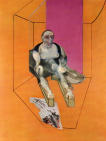
FRANCIS BACON
Muriel Belcher (Sphinx), 1979
oil on canvas
return to Colony Room members
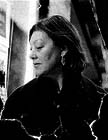 : : 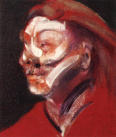
JOHN DEAKIN: photo of Rawsthorne, c. 1952
FRANCIS BACON: painting of Rawsthorne, c. 1965
INDEX

Stage design
by
Isabel Lambert (Rawsthorne)
(image source)
INDEX
|
|
SOHO, LONDON
"'When I first knew Soho the prostitutes were all over the streets.
The streets were more fun, more amusing.
The prostitutes gave a living sense to the streets." - Bacon to Farson
- Map of Soho @ Soho Society
- Bacon's
Soho
- Colony Room: "Lazy afternoons, drinking champagne in Dean Street's Colony Room, was Francis Bacon's favourite muse throughout the 1950s; meanwhile his reputation grew from low-life rent-boy to the world's greatest artist. Here he was surrounded by an entourage - not the bitchy queens, snooty art critics and aspirant artists, whom he loathed and later claimed harangued him out of Soho (he hated the insincerity of fans) - but his real friends; Soho eccentrics of a bygone age. As he put-it, 'Champagne for real friends, real pain for sham friends!'"
- 'Old Compton Street at the base led into Brewer Street, lined with restaurants and food and wine stores...Blocks of ice outside the shuttered restaurants started to dribble across the pavements, and kept the fish fresh at Richards. The markets were alive with fruit and vegetables: Rupert Street smaller and posher; Berwick Street, heading north, cheaper, noisier and more crowded.'
- Wheeler's , Bacon's favourite restaurant. "The speciality was oysters - unsurpassed for succulent. Bacon was always welcomed by the manager, despite the tendency of his rambunctious crowd to scare off wealthy tourists, and his credit tab running into thousands of pounds (which he eventually settled with a painting)"
- The Caves de France was where Bacon drank with Robert MacBryde and Robert Colquhoun. "Known as the Two Roberts, after meeting at the Glasgow School of Art in 1932, they lived together for the rest of their lives."
- Also: The York Minster, known as The French Pub, The Rockingham Club, The Golden Lion, and The Gargoyle in Meard Street.
- Museum of London: Creative Quarters: Soho 1950s
- The Gargoyle Club on Meard's Street was another haunt for many artists. "Founded in 1925, it had been the epitome of decadent glamour, but by the 1950s had become a seedy drinking den. Francis Bacon and Lucian Freud were regulars and painter John Minton was known for his frenetic solos on the dance-floor. He committed suicide four years after this portrait was painted." - Museum of London
- Wheeler Restaurant ". . . A typical day for Bacon would start with furious painting followed by lunch at Wheelers in Compton Street, his favourite Soho restaurant selling seafood and oysters, where he would buy everyone champagne. . ." -Museum of London.
- Soho Society Present Artists
INDEX
|



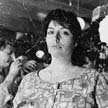
 :
: 






 She also established a cult of rudeness. Belcher's favourite word was "cunt", delivered in ringing tones, and a hierarchy of insults ensued. "'Cunt' was a term of abuse, 'Cunty' was meant affectionately," says the Chairman. "And if she called you 'Mary', you were really in." Men would be called "she". "Muriel made everything sound good, even when it wasn't exactly a Wildeanepigram," says Melly. "She was camp, and the very delivery of camp makes your sentences sound witty." The Colony thus became a kind of anti-Cheers, where everyone may have known your name but instead called you "cunty."
She also established a cult of rudeness. Belcher's favourite word was "cunt", delivered in ringing tones, and a hierarchy of insults ensued. "'Cunt' was a term of abuse, 'Cunty' was meant affectionately," says the Chairman. "And if she called you 'Mary', you were really in." Men would be called "she". "Muriel made everything sound good, even when it wasn't exactly a Wildeanepigram," says Melly. "She was camp, and the very delivery of camp makes your sentences sound witty." The Colony thus became a kind of anti-Cheers, where everyone may have known your name but instead called you "cunty."

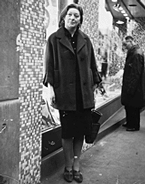 ". . . She had an astonishing life. In the 1930s she was sculpted by Jacob Epstein, then in Paris she was painted by Derain, by Picasso, sculpted by Giacometti, and as if that were not enough, back in London in the 1960s, Francis Bacon got his horribly skilful hands at work on portraits of her. . .She liked to drink, and she liked men who liked to drink. She married three of them: Sefton Delmer, a foreign correspondent; Constant Lambert, distinguished conductor, composer and one of the leading lights in the founding of what is now the Royal Ballet, who died of delirium tremens; and then the composer Alan Rawsthorne . . ."
". . . She had an astonishing life. In the 1930s she was sculpted by Jacob Epstein, then in Paris she was painted by Derain, by Picasso, sculpted by Giacometti, and as if that were not enough, back in London in the 1960s, Francis Bacon got his horribly skilful hands at work on portraits of her. . .She liked to drink, and she liked men who liked to drink. She married three of them: Sefton Delmer, a foreign correspondent; Constant Lambert, distinguished conductor, composer and one of the leading lights in the founding of what is now the Royal Ballet, who died of delirium tremens; and then the composer Alan Rawsthorne . . ."